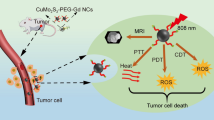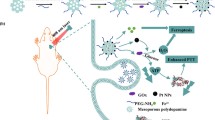Abstract
Although chemotherapy has been intensively applied in cancer treatments, its inadequate therapeutic efficacy and severe side effects are still under constant concerns. Nanoplatforms used as anti-tumor drug delivery system (DDS) have attracted tremendous attentions owing to their various intriguing properties. Herein, Mn-doped MoO2 nanoparticles coated with ZrO2 and capped with Bi2O3 have been designed as a DDS, namely MMZB. MMZB possesses good magnetic properties, great photothermal conversion ability, sensitive tumor microenvironment (TME) responsiveness, and good biocompatibility in hemocompatibility in vitro. Thus, MMZB has been utilized to load the chemotherapeutic agent daunomycin (DNM) (MMZB@DNM) for chemo-photothermal combined therapy. MMZB@DNM demonstrates a more impressive anti-cancer effect than the individual photothermal or chemotherapy both in vitro and in vivo. Furthermore, the analysis of tumor specimen sections and serum levels after the treatment indicates negligible side effects for MMZB@DNM in vivo. This contribution provides a valuable concept in designing therapeutic agents for achieving significantly enhanced tumor treatments, which benefits from the synergistic combination of chemotherapy and photothermal therapy in one single nanoagent.
Graphical abstract

摘要
尽管化疗在癌症治疗中得到广泛的应用, 但其不理想的疗效和严重的副作用仍然备受关注。纳米平台作为抗肿瘤药物递送系统 (DDS), 由于其各种有趣的特性而引起了人们的极大关注。在此, 用ZrO2包裹并用Bi2O3封堵的Mn掺杂MoO2纳米颗粒被设计为DDS, 即MMZB。MMZB具有良好的磁性、良好的光热转换能力、敏感的肿瘤微环境反应性和良好的体外血液相容性。因此, MMZB被用于装载化疗剂柔红霉素 (DNM) (MMZB@DNM)用于化学-光热联合治疗。MMZB@DNM在体外和体内显示出比单独的光热或化学疗法更优异的抗癌效果。此外, 对肿瘤标本切片和治疗后血清水平的分析表明MMZB@DNM体内副作用很低。本工作将化疗和光热治疗组合在单一纳米体系, 为抗肿瘤药物研发提供了新的思路。






Similar content being viewed by others
References
Simone SS, Joana MG, Rui LR, Subhas CK. Green solvents combined with bioactive compounds as delivery systems: present status and future trends. ACS Appl Bio Mater. 2021;4(5):4000. https://doi.org/10.1021/acsabm.1c00013.
Qu XY, Hong Y, Cai H, Sun X, Shen Q, Yang DL, Dong XC, Jiao AH, Chen P, Shao JJ. Promoted intramolecular photoinduced-electron transfer for multi-mode imaging-guided cancer photothermal therapy. Rare Met. 2022;41(1):56. https://doi.org/10.1007/s12598-021-01795-0.
Wang ZY, Mei J, Ni DQ, Li SM, Ye JM, Li SL, Wang YL, Liu Y. A nanoplatform self-assembled by coordination delivers siRNA for lung cancer therapy. Rare Met. 2023;42(5):1483. https://doi.org/10.1007/s12598-022-02185-w.
Itoo AM, Paul M, Padaga SG, Ghosh B, Biswas S. Nanotherapeutic intervention in photodynamic therapy for cancer. ACS Omega. 2022;7(50):45882. https://doi.org/10.1021/acsomega.2c05852.
Liao SL, Cai MR, Zhu RY, Fu TT, Du YJ, Kong JH, Zhang YQ, Qu CH, Dong XX, Ni J, Yin XB. Antitumor effect of photodynamic therapy/sonodynamic therapy/sono-photodynamic therapy of chlorin e6 and other applications. Mol Pharm. 2023;20(2):875. https://doi.org/10.1021/acs.molpharmaceut.2c00824.
Overchuk M, Weersink RA, Wilson BC, Zheng G. Photodynamic and photothermal therapies: synergy opportunities for nanomedicine. ACS Nano. 2023;17(9):7979. https://doi.org/10.1021/acsnano.3c00891.
Ding ZL, Gu YH, Zheng C, Gu YQ, Yang J, Li DH, Xu YN, Wang P. Organic small molecule-based photothermal agents for cancer therapy: design strategies from single-molecule optimization to synergistic enhancement. Coord Chem Rev. 2022;464:214564. https://doi.org/10.1016/j.ccr.2022.214564.
Xiao LH, Chen X, Yang XY, Sun JH, Geng JX. Recent advances in polymer-based photothermal materials for biological applications. ACS Appl Polym Mater. 2020;2(10):4273. https://doi.org/10.1021/acsapm.0c00711.
Calori IR, Bi H, Tedesco AC. Expanding the limits of photodynamic therapy: the design of organelles and hypoxia-targeting nanomaterials for enhanced photokilling of cancer. ACS Appl Bio Mater. 2021;4(1):195. https://doi.org/10.1021/acsabm.0c00945.
Li K, Zhang YQ, Hussain A, Weng YH, Huang YY. Progress of photodynamic and RNAi combination therapy in cancer treatment. ACS Biomater Sci Eng. 2021;7(9):4420. https://doi.org/10.1021/acsbiomaterials.1c00765.
Alamdari SG, Amini M, Jalilzadeh N, Baradaran B, Mohammadzadeh R, Mokhtarzadeh A, Oroojalian F. Recent advances in nanoparticle-based photothermal therapy for breast cancer. J Control Release. 2022;349:269. https://doi.org/10.1016/j.jconrel.2022.06.050.
Ren Y, Yan YY, Qi H. Photothermal conversion and transfer in photothermal therapy: from macroscale to nanoscale. Adv Colloid Interface Sci. 2022;308:102753. https://doi.org/10.1016/j.cis.2022.102753.
Zhu HJ, Li BF, Chan CY, Low B, Ling Q, Tor JQ, Oh XY, Jiang WB, Ye EY, Li ZB, Loh XJ. Advances in single-component inorganic nanostructures for photoacoustic imaging guided photothermal therapy. Adv Drug Deliver Rev. 2023;192:114644. https://doi.org/10.1016/j.addr.2022.114644.
Shu Y, Lh XY, Zhao Y, Chen Z, Zhang JW, Shan D, Liu WQ, Di MY, Wang BQ. Photodynamic and photothermal therapy-driven synergistic cancer treatment assisted by zeolitic imidazolate framework-8: a review. J Drug Deliv Sci Technol. 2023;81:104272. https://doi.org/10.1016/j.jddst.2023.104272.
Bian WQ, Wang YK, Pan ZX, Chen NP, Li XJ, Wong WL, Liu XJ, He Y, Zhang K, Lu YJ. Review of functionalized nanomaterials for photothermal therapy of cancers. ACS Appl Nano Mater. 2021;4(11):11353. https://doi.org/10.1021/acsanm.1c01903.
Sun HT, Zhang Q, Li JC, Peng SJ, Wang XL, Cai R. Near-infrared photoactivated nanomedicines for photothermal synergistic cancer therapy. Nano Today. 2021;37:101073. https://doi.org/10.1016/j.nantod.2020.101073.
Ou MT, Lin CC, Wang Y, Lu YT, Wang WY, Li ZM, Zeng WW, Zeng XW, Ji XY, Mei L. Heterojunction engineered bioactive chlorella for cascade promoted cancer therapy. J Control Release. 2022;345:755. https://doi.org/10.1016/j.jconrel.2022.03.059.
Li ZM, Yang Y, Wei HX, Shan XT, Wang XZ, Ou MT, Liu QY, Gao NS, Chen HZ, Mei L, Zeng XW. Charge-reversal biodegradable MSNs for tumor synergetic chemo/photothermal and visualized therapy. J Control Release. 2021;338:719. https://doi.org/10.1016/j.jconrel.2021.09.005.
Mustafa RA, Ran MX, Wang YH, Yan JQ, Zhang Y, Rosenholm JM, Zhang HB. a pH/temperature responsive nanocomposite for chemo-photothermal synergistic cancer therapy. Smart Mater Med. 2023;4:199. https://doi.org/10.1016/j.smaim.2022.09.004.
Zeng XW, Luo MM, Liu G, Wang XS, Tao W, Lin YX, Ji XY, Nie L, Mei L. Polydopamine-modified black phosphorous nanocapsule with enhanced stability and photothermal performance for tumor multimodal treatments. Adv Sci. 2018;5(10):1800510. https://doi.org/10.1002/advs.201800510.
Pourmadadi M, Tajiki A, Hosseini SM, Samadi A, Abdouss M, Daneshnia S, Yazdian F. A comprehensive review of synthesis, structure, properties, and functionalization of MoS2; emphasis on drug delivery, photothermal therapy, and tissue engineering applications. J Drug Deliv Sci Technol. 2022;76:103767. https://doi.org/10.1016/j.jddst.2022.103767.
Dheyab MA, Aziz AA, Khaniabadi PM, Jameel MS, Oladzadabbasabadi N, Rahman AA, Braim FS, Mehrdel B. Gold nanoparticles-based photothermal therapy for breast cancer. Photodiagnosis Photodyn Ther. 2023;42:103312. https://doi.org/10.1016/j.pdpdt.2023.103312.
Wang ZT, Wang ML, Wang XX, Hao ZK, Han SB, Wang T, Zhang HY. Photothermal-based nanomaterials and photothermal-sensing: an overview. Biosens Bioelectron. 2023;220:114883. https://doi.org/10.1016/j.bios.2022.114883.
Fang C, Yan PJ, Ren ZH, Wang YF, Cai XJ, Li X, Han GR. Multifunctional MoO2-ICG nanoplatform for 1064 nm-mediated synergeticphotodynamic/photothermal therapy. Appl Mater Today. 2019;15:472. https://doi.org/10.1016/j.apmt.2019.03.008.
Dhas N, Kudarha R, Garkal A, Ghate V, Sharma S, Panzade P, Khot S, Chaudhari P, Singh A, Paryani M, Lewis S, Garg N, Singh N, Bangar P, Meh T. Molybdenum-based hetero-nanocomposites for cancer therapy, diagnosis and biosensing application: current advancement and future breakthroughs. J Control Release. 2021;330:257. https://doi.org/10.1016/j.jconrel.2020.12.015.
Liu JM, Lu KD, Gao FC, Zhao L, Li H, Jiang YY. Multifunctional MoS2 composite nanomaterials for drug delivery and synergistic photothermal therapy in cancer treatment. Ceram Int. 2022;48(15):22378. https://doi.org/10.1016/j.ceramint.2022.04.244.
Chen YS, Gao ML, Zhang LJ, Ha EN, Hu X, Zou RJ, Yan L, Hu JQ. Tumor microenvironment responsive biodegradable Fe-doped MoOx nanowires for magnetic resonance imaging guided photothermal-enhanced chemodynamic synergistic antitumor therapy. Adv Healthc Mater. 2020;24:2001665. https://doi.org/10.1002/adhm.202001665.
Zhu H, Zheng K, Boccaccini AR. Multi-functional silica-based mesoporous materials for simultaneous delivery of biologically active ions and therapeutic biomolecules. Acta Biomater. 2021;129:1. https://doi.org/10.1016/j.actbio.2021.05.007.
AbouAitah K, Lojkowski W. Delivery of natural agents by means of mesoporous silica nanospheres as a promising anticancer strategy. Pharmaceutics. 2021;13(2):143. https://doi.org/10.3390/pharmaceutics13020143.
Shi ZQ, Zhou Y, Fan TJ, Lin YX, Zhang H, Mei L. Inorganic nano-carriers based smart drug delivery systems for tumor therapy. Smart Mater Med. 2020;1:32. https://doi.org/10.1016/j.smaim.2020.05.002.
Croissant JG, Fatieiev Y, Khashab NM. Degradability and clearance of silicon, organosilica, silsesquioxane, silica mixed oxide, and mesoporous silica nanoparticles. Adv Mater. 2017;29(9):1604634. https://doi.org/10.1002/adma.201604634.
Madeira S, Buciumeanu M, Nobre D, Carvalho O, Silva FS. Development of a novel hybrid Ti6Al4V–ZrO2 surface with high wear resistance by laser and hot pressing techniques for dental implants. J Mech Behav Biomed. 2022;136:105508. https://doi.org/10.1016/j.jmbbm.2022.105508.
Swathi NVR, Patrick H, Adam P, Mateusz M, Rafal T, Christian P, Manuela SK. Nanodentistry aspects explored towards nanostructured ZrO2: immobilizing zirconium-oxide nanotube coatings onto zirconia ceramic implant surfaces. Open Ceram. 2023;14:100340. https://doi.org/10.1016/j.oceram.2023.100340.
Zhang L, Zhang WT, Han Y, Tang W. A nanoplate-like α-Al2O3 out-layered Al2O3-ZrO2 coating fabricated by micro-arc oxidation for hip joint prosthesis. Appl Surf Sci. 2016;15:141. https://doi.org/10.1016/j.apsusc.2015.11.132.
Fang WK, Wang Z, Xie Q, Liu Y, Wu DY. Formation of Fe3O4@ZrO2 nanocomposite and its performance as a magnetic adsorbent for phosphate uptake: influences of end-point pH and stirring rate during synthesis process. Chem Eng Res Des. 2019;145:194. https://doi.org/10.1016/j.cherd.2019.03.013.
Kim D, Jung D. Enhancement of photocatalytic activity over Bi2O3/black-BiOCl heterojunction. Chem Phys Lett. 2017;674:130. https://doi.org/10.1016/j.cplett.2017.02.034.
Keogan DM, Griffith DM. Current and potential applications of bismuth-based drugs. Molecules. 2014;19(9):15258. https://doi.org/10.3390/molecules190915258.
Yu XJ, Liu XY, Yang K, Chen XY, Li WW. Pnictogen semimetal (Sb, Bi)-based nanomaterials for cancer imaging and therapy: a materials perspective. ACS Nano. 2021;15(2):2038. https://doi.org/10.1021/acsnano.0c07899.
Wang H, Yang JL, Cao PH, Guo N, Li YH, Zhao YF, Zhou S, Ouyang RZ, Miao YQ. Functionalization of bismuth sulfide nanomaterials for their application in cancer theranostics. Chin Chem Lett. 2020;31(12):3015. https://doi.org/10.1016/j.cclet.2020.05.003.
Bogusz K, Tehei M, Stewart C, Mcdonald M, Cardillo D, Lerch M, Corde S, Rosenfeld A, Liu HK, Konstantinov K. Synthesis of potential theranostic system consisting of methotrexate-immobilized (3-aminopropyl) trimethoxysilane coated α-Bi2O3 nanoparticles for cancer treatment. RSC Adv. 2014;4(46):24412. https://doi.org/10.1039/C4RA02160F.
Tao C, Zhao F, Tang ZW, Zhang LX, Niu Q, Cao G, Zhao LM, Huang WH, Zhao P. Bi2O3 gated Fe3O4@ZrO2 core/shell drug delivery system for chemo/ionic synergistic therapeutics. J Solid State Chem. 2021;303:122489. https://doi.org/10.1016/j.jssc.2021.122489.
Sun CX, Wen L, Zeng JF, Wang Y, Sun Q, Deng LJ, Zhao CJ, Li Z. One-pot solventless preparation of PEGylated black phosphorus nanoparticles for photoacoustic imaging and photothermal therapy of cancer. Biomaterials. 2016;91:81. https://doi.org/10.1016/j.biomaterials.2016.03.022.
Roper DK, Ahn W, Hoepfner M. Microscale heat transfer transduced by surface plasmon resonant gold nanoparticles. J Phys Chem C. 2007;111(9):3636. https://doi.org/10.1021/jp064341w.
Liu MC, Sun XY, Liao ZH, Li YH, Qi XL, Qian YN, Fenniri H, Zhao P, Shen JL. Zinc oxide end-capped Fe3O4@mSiO2 coreshell nanocarriers as targeted and responsive drug delivery system for chemo-/ions synergistic therapeutics. Drug Deliv. 2019;26(1):732. https://doi.org/10.1080/10717544.2019.1642419.
Chou TC, Talalay P. Quantitative analysis of dose-effect relationships: the combined effects of multiple drugs or enzyme inhibitors. Adv Enzyme Regul. 1984;22:27. https://doi.org/10.1016/0065-2571(84)90007-4.
Zhao L, Wientjes MG, Au JLS. Evaluation of combination chemotherapy integration of nonlinear regression, curve shift, isobologram, and combination index analyses. Clin Cancer Res. 2004;10(23):7994. https://doi.org/10.1158/1078-0432.ccr-04-1087.
Pugazhendhi A, Edison TNJI, Velmurugan BK, Jacob JA, Karuppusamy I. Toxicity of Doxorubicin (Dox) to different experimental organ systems. Life Sci. 2018;200:26. https://doi.org/10.1016/j.lfs.2018.03.023.
Rawat PS, Jaiswal A, Khurana A, Bhatti JS, Navik U. Doxorubicin-induced cardiotoxicity: an update on the molecular mechanism and novel therapeutic strategies for effective management. Biomed Pharmacother. 2021;139:111708. https://doi.org/10.1016/j.biopha.2021.111708.
Oliveira JPF, Santos C, Fernandes E. Therapeutic potential of hesperidin and its aglycone hesperetin: cell cycle regulation and apoptosis induction in cancer models. Phytomedicine. 2020;73:152887. https://doi.org/10.1016/j.phymed.2019.152887.
Magni M, Buscemi G, Zannini L. Cell cycle and apoptosis regulator 2 at the interface between DNA damage response and cell physiology. Mutat Res-rev. 2018;776:1. https://doi.org/10.1016/j.mrrev.2018.03.004.
Acknowledgements
This study was financially supported by the National Natural Science Foundation of China (Nos. 22271178 and 22001156), Project of Special Key Fields in Guangdong Province (No. 2021ZDZX4019), the Science and technology innovation strategy of Guangdong province (No. 51361212), and Guangdong Provincial Science and Technology Innovation Strategy Special Fund Approval Project (No. pdjh2021b0266).
Author information
Authors and Affiliations
Corresponding authors
Ethics declarations
Conflict of interests
The authors declare that they have no conflict of interest.
Supplementary Information
Below is the link to the electronic supplementary material.
Rights and permissions
Springer Nature or its licensor (e.g. a society or other partner) holds exclusive rights to this article under a publishing agreement with the author(s) or other rightsholder(s); author self-archiving of the accepted manuscript version of this article is solely governed by the terms of such publishing agreement and applicable law.
About this article
Cite this article
Zhao, P., Zheng, HF., Peng, J. et al. Drug delivery with Mn-doped MoO2 for photothermal-enhanced chemotherapy in fighting cancers. Rare Met. 43, 2230–2240 (2024). https://doi.org/10.1007/s12598-023-02568-7
Received:
Revised:
Accepted:
Published:
Issue Date:
DOI: https://doi.org/10.1007/s12598-023-02568-7




